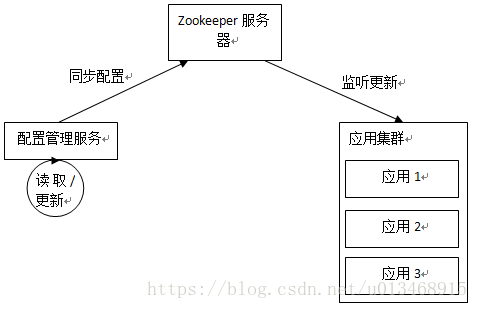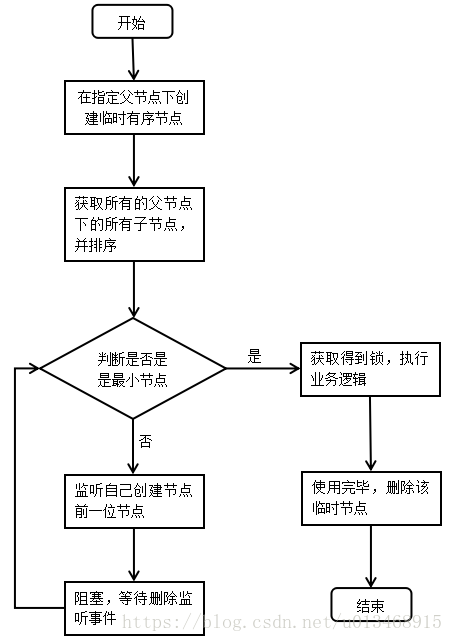Zookeeper 典型应用场景场景
之前自己写了一些关于Zookeeper的基础知识,Zookeeper作为一种协调分布式应用高性能的调度服务,实际的应用场景也非常的广泛,这里主要通过几个例子来具体的说明Zookeeper在特定场景下的使用方式(下面的这些功能估计consul和etcd也能实现,以后学到了再说吧)。
2.1.一致性配置管理
我们在开发的时候,有时候需要获取一些公共的配置,比如数据库连接信息等,并且偶然可能需要更新配置。如果我们的服务器有N多台的话,那修改起来会特别的麻烦,并且还需要重新启动。这里Zookeeper就可以很方便的实现类似的功能。
2.1.1.思路
1. 将公共的配置存放在Zookeeper的节点中
2. 应用程序可以连接到Zookeeper中并对Zookeeper中配置节点进行读取或者修改(对于写操作可以进行权限验证设置),下面是具体的流程图:

2.1.2.事例
public class CommonConfig implements Serializable{
// 数据库连接配置
private String dbUrl;
private String username;
private String password;
private String driverClass;
public CommonConfig() {}
public CommonConfig(String dbUrl, String username, String password, String driverClass) {
super();
this.dbUrl = dbUrl;
this.username = username;
this.password = password;
this.driverClass = driverClass;
}
public String getDbUrl() {
return dbUrl;
}
public void setDbUrl(String dbUrl) {
this.dbUrl = dbUrl;
}
public String getUsername() {
return username;
}
public void setUsername(String username) {
this.username = username;
}
public String getPassword() {
return password;
}
public void setPassword(String password) {
this.password = password;
}
public String getDriverClass() {
return driverClass;
}
public void setDriverClass(String driverClass) {
this.driverClass = driverClass;
}
@Override
public String toString() {
return "CommonConfig:{dbUrl:" + this.dbUrl +
", username:" + this.username +
", password:" + this.password +
", driverClass:" + this.driverClass + "}";
}
}public class ZkConfigMng {
private String nodePath = "/commConfig";
private CommonConfig commonConfig;
private ZkClient zkClient;
public CommonConfig initConfig(CommonConfig commonConfig) {
if(commonConfig == null) {
this.commonConfig = new CommonConfig("jdbc:mysql://127.0.0.1:3306/mydata?useUnicode=true&characterEncoding=utf-8",
"root", "root", "com.mysql.jdbc.Driver");
} else {
this.commonConfig = commonConfig;
}
return this.commonConfig;
}
/**
* 更新配置
*
* @param commonConfig
* @return
*/
public CommonConfig update(CommonConfig commonConfig) {
if(commonConfig != null) {
this.commonConfig = commonConfig;
}
syncConfigToZookeeper();
return this.commonConfig;
}
public void syncConfigToZookeeper() {
if(zkClient == null) {
zkClient = new ZkClient("127.0.0.1:2181");
}
if(!zkClient.exists(nodePath)) {
zkClient.createPersistent(nodePath);
}
zkClient.writeData(nodePath, commonConfig);
}
}public class ZkConfigClient implements Runnable {
private String nodePath = "/commConfig";
private CommonConfig commonConfig;
@Override
public void run() {
ZkClient zkClient = new ZkClient(new ZkConnection("127.0.0.1:2181", 5000));
while (!zkClient.exists(nodePath)) {
System.out.println("配置节点不存在!");
try {
TimeUnit.SECONDS.sleep(1);
} catch (InterruptedException e) {
e.printStackTrace();
}
}
// 获取节点
commonConfig = (CommonConfig)zkClient.readData(nodePath);
System.out.println(commonConfig.toString());
zkClient.subscribeDataChanges(nodePath, new IZkDataListener() {
@Override
public void handleDataDeleted(String dataPath) throws Exception {
if(dataPath.equals(nodePath)) {
System.out.println("节点:" + dataPath + "被删除了!");
}
}
@Override
public void handleDataChange(String dataPath, Object data) throws Exception {
if(dataPath.equals(nodePath)) {
System.out.println("节点:" + dataPath + ", 数据:" + data + " - 更新");
commonConfig = (CommonConfig) data;
}
}
});
}
}下面启动Main函数
配置管理服务启动
public static void main(String[] args) throws InterruptedException {
SpringApplication.run(ZookeeperApiDemoApplication.class, args);
ZkConfigMng zkConfigMng = new ZkConfigMng();
zkConfigMng.initConfig(null);
zkConfigMng.syncConfigToZookeeper();
TimeUnit.SECONDS.sleep(10);
// 修改值
zkConfigMng.update(new CommonConfig("jdbc:mysql://192.168.1.122:3306/mydata?useUnicode=true&characterEncoding=utf-8",
"root", "wxh", "com.mysql.jdbc.Driver"));
}
}
public static void main(String[] args) throws InterruptedException {
SpringApplication.run(ZookeeperApiDemoApplication.class, args);
ExecutorService executorService = Executors.newFixedThreadPool(3);
// 模拟多个客户端获取配置
executorService.submit(new ZkConfigClient());
executorService.submit(new ZkConfigClient());
executorService.submit(new ZkConfigClient());
}
}
public class DistributedLock {
// 常亮
static class Constant {
private static final int SESSION_TIMEOUT = 10000;
private static final String CONNECTION_STRING = "127.0.0.1:2181";
private static final String LOCK_NODE = "/distributed_lock";
private static final String CHILDREN_NODE = "/task_";
}
private ZkClient zkClient;
public DistributedLock() {
// 连接到Zookeeper
zkClient = new ZkClient(new ZkConnection(Constant.CONNECTION_STRING));
if(!zkClient.exists(Constant.LOCK_NODE)) {
zkClient.create(Constant.LOCK_NODE, "分布式锁节点", CreateMode.PERSISTENT);
}
}
public String getLock() {
try {
// 1。在Zookeeper指定节点下创建临时顺序节点
String lockName = zkClient.createEphemeralSequential(Constant.LOCK_NODE + Constant.CHILDREN_NODE, "");
// 尝试获取锁
acquireLock(lockName);
return lockName;
} catch(Exception e) {
e.printStackTrace();
}
return null;
}
/**
* 获取锁
* @throws InterruptedException
*/
public Boolean acquireLock(String lockName) throws InterruptedException {
// 2.获取lock节点下的所有子节点
List childrenList = zkClient.getChildren(Constant.LOCK_NODE);
// 3.对子节点进行排序,获取最小值
Collections.sort(childrenList, new Comparator() {
@Override
public int compare(String o1, String o2) {
return Integer.parseInt(o1.split("_")[1]) - Integer.parseInt(o2.split("_")[1]);
}
});
// 4.判断当前创建的节点是否在第一位
int lockPostion = childrenList.indexOf(lockName.split("/")[lockName.split("/").length - 1]);
if(lockPostion < 0) {
// 不存在该节点
throw new ZkNodeExistsException("不存在的节点:" + lockName);
} else if (lockPostion == 0) {
// 获取到锁
System.out.println("获取到锁:" + lockName);
return true;
} else if (lockPostion > 0) {
// 未获取到锁,阻塞
System.out.println("...... 未获取到锁,阻塞等待 。。。。。。");
// 5.如果未获取得到锁,监听当前创建的节点前一位的节点
final CountDownLatch latch = new CountDownLatch(1);
IZkDataListener listener = new IZkDataListener() {
@Override
public void handleDataDeleted(String dataPath) throws Exception {
// 6.前一个节点被删除,当不保证轮到自己
System.out.println("。。。。。。前一个节点被删除 。。。。。。");
acquireLock(lockName);
latch.countDown();
}
@Override
public void handleDataChange(String dataPath, Object data) throws Exception {
// 不用理会
}
};
try {
zkClient.subscribeDataChanges(Constant.LOCK_NODE + "/" + childrenList.get(lockPostion - 1), listener);
latch.await();
} finally {
zkClient.unsubscribeDataChanges(Constant.LOCK_NODE + "/" + childrenList.get(lockPostion - 1), listener);
}
}
return false;
}
/**
* 释放锁(删除节点)
*
* @param lockName
*/
public void releaseLock(String lockName) {
zkClient.delete(lockName);
}
public void closeZkClient() {
zkClient.close();
}
}
@SpringBootApplication
public class ZookeeperDemoApplication {
public static void main(String[] args) throws InterruptedException {
SpringApplication.run(ZookeeperDemoApplication.class, args);
DistributedLock lock = new DistributedLock();
String lockName = lock.getLock();
/**
* 执行我们的业务逻辑
*/
if(lockName != null) {
lock.releaseLock(lockName);
}
lock.closeZkClient();
}
} 1. 首先利用Zookeeper中临时顺序节点的特点
2. 当生产者创建节点生产时,需要判断父节点下临时顺序子节点的个数,如果达到了上限,则阻塞等待;如果没有达到,就创建节点。
3. 当消费者获取节点时,如果父节点中不存在临时顺序子节点,则阻塞等待;如果有子节点,则获取执行自己的业务,执行完毕后删除该节点即可。
4. 获取时获取最小值,保证FIFO特性。
public interface AppConstant {
static String ZK_CONNECT_STR = "127.0.0.1:2181";
static String NODE_PATH = "/mailbox";
static String CHILD_NODE_PATH = "/mail_";
static int MAILBOX_SIZE = 10;
}
public class MailConsumer implements Runnable, AppConstant{
private ZkClient zkClient;
private Lock lock;
private Condition condition;
public MailConsumer() {
lock = new ReentrantLock();
condition = lock.newCondition();
zkClient = new ZkClient(new ZkConnection(ZK_CONNECT_STR));
System.out.println("sucess connected to zookeeper server!");
// 不存在就创建mailbox节点
if(!zkClient.exists(NODE_PATH)) {
zkClient.create(NODE_PATH, "this is mailbox", CreateMode.PERSISTENT);
}
}
@Override
public void run() {
IZkChildListener listener = new IZkChildListener() {
@Override
public void handleChildChange(String parentPath, List currentChilds) throws Exception {
System.out.println("Znode["+parentPath + "] size:" + currentChilds.size());
// 还是要判断邮箱是否为空
if(currentChilds.size() > 0) {
// 唤醒等待的线程
try {
lock.lock();
condition.signal();
} catch (Exception e) {
e.printStackTrace();
} finally {
lock.unlock();
}
}
}
};
// 监视子节点的改变,不用放用while循环中,监听一次就行了,不需要重复绑定
zkClient.subscribeChildChanges(NODE_PATH, listener);
try {
//循环随机发送邮件模拟真是情况
while(true) {
// 判断是否可以发送邮件
checkMailReceive();
// 接受邮件
List mailList = zkClient.getChildren(NODE_PATH);
// 如果mailsize==0,也没有关系;可以直接循环获取就行了
if(mailList.size() > 0) {
Collections.sort(mailList, new Comparator() {
@Override
public int compare(String o1, String o2) {
return Integer.parseInt(o1.split("_")[1]) - Integer.parseInt(o2.split("_")[1]);
}
});
// 模拟邮件处理(0-1S)
TimeUnit.MILLISECONDS.sleep(new Random().nextInt(1000));
zkClient.delete(NODE_PATH + "/" + mailList.get(0));
System.out.println("mail has been received:" + NODE_PATH + "/" + mailList.get(0));
}
}
}catch (Exception e) {
e.printStackTrace();
} finally {
zkClient.unsubscribeChildChanges(NODE_PATH, listener);
}
}
private void checkMailReceive() {
try {
lock.lock();
// 判断邮箱是为空
List mailList = zkClient.getChildren(NODE_PATH);
System.out.println("mailbox size: " + mailList.size());
if(mailList.size() == 0) {
// 邮箱为空,阻塞消费者,直到邮箱有邮件
System.out.println("mailbox is empty, please wait 。。。");
condition.await();
// checkMailReceive();
}
} catch (Exception e) {
e.printStackTrace();
} finally {
lock.unlock();
}
}
}
public class MailProducer implements Runnable, AppConstant{
private ZkClient zkClient;
private Lock lock;
private Condition condition;
/**
* 初始化状态
*/
public MailProducer() {
lock = new ReentrantLock();
condition = lock.newCondition();
zkClient = new ZkClient(new ZkConnection(ZK_CONNECT_STR));
System.out.println("sucess connected to zookeeper server!");
// 不存在就创建mailbox节点
if(!zkClient.exists(NODE_PATH)) {
zkClient.create(NODE_PATH, "this is mailbox", CreateMode.PERSISTENT);
}
}
@Override
public void run() {
IZkChildListener listener = new IZkChildListener() {
@Override
public void handleChildChange(String parentPath, List currentChilds) throws Exception {
System.out.println("Znode["+parentPath + "] size:" + currentChilds.size());
// 还是要判断邮箱是否已满
if(currentChilds.size() < MAILBOX_SIZE) {
// 唤醒等待的线程
try {
lock.lock();
condition.signal();
} catch (Exception e) {
e.printStackTrace();
} finally {
lock.unlock();
}
}
}
};
// 监视子节点的改变,不用放用while循环中,监听一次就行了,不需要重复绑定
zkClient.subscribeChildChanges(NODE_PATH, listener);
try {
//循环随机发送邮件模拟真是情况
while(true) {
// 判断是否可以发送邮件
checkMailSend();
// 发送邮件
String cretePath = zkClient.createEphemeralSequential(NODE_PATH + CHILD_NODE_PATH, "your mail");
System.out.println("your mail has been send:" + cretePath);
// 模拟随机间隔的发送邮件(0-10S)
TimeUnit.MILLISECONDS.sleep(new Random().nextInt(1000));
}
}catch (Exception e) {
e.printStackTrace();
} finally {
zkClient.unsubscribeChildChanges(NODE_PATH, listener);
}
}
private void checkMailSend() {
try {
lock.lock();
// 判断邮箱是否已满
List mailList = zkClient.getChildren(NODE_PATH);
System.out.println("mailbox size: " + mailList.size());
if(mailList.size() >= MAILBOX_SIZE) {
// 邮箱已满,阻塞生产者,直到邮箱有空间
System.out.println("mailbox is full, please wait 。。。");
condition.await();
checkMailSend();
}
} catch (Exception e) {
e.printStackTrace();
} finally {
lock.unlock();
}
}
} 
/**
* 服务提供者
*
* @author Administrator
*
*/
public class ServiceProvider {
// 静态常量
static String ZK_CONNECT_STR = "127.0.0.1:2181";
static String NODE_PATH = "/service";
static String SERIVCE_NAME = "/myService";
private ZkClient zkClient;
public ServiceProvider() {
zkClient = new ZkClient(new ZkConnection(ZK_CONNECT_STR));
System.out.println("sucess connected to zookeeper server!");
// 不存在就创建NODE_PATH节点
if(!zkClient.exists(NODE_PATH)) {
zkClient.create(NODE_PATH, "this is mailbox", CreateMode.PERSISTENT);
}
}
public void registryService(String localIp, Object obj) {
if(!zkClient.exists(NODE_PATH + SERIVCE_NAME)) {
zkClient.create(NODE_PATH + SERIVCE_NAME, "provider services list", CreateMode.PERSISTENT);
}
// 对自己的服务进行注册
zkClient.createEphemeral(NODE_PATH + SERIVCE_NAME + "/" + localIp, obj);
System.out.println("注册成功![" + localIp + "]");
}
}
/**
* 消费者,通过某种均衡负载算法选择某一个提供者
*
* @author Administrator
*
*/
public class ServiceConsumer {
// 静态常量
static String ZK_CONNECT_STR = "127.0.0.1:2181";
static String NODE_PATH = "/service";
static String SERIVCE_NAME = "/myService";
private List serviceList = new ArrayList();
private ZkClient zkClient;
public ServiceConsumer() {
zkClient = new ZkClient(new ZkConnection(ZK_CONNECT_STR));
System.out.println("sucess connected to zookeeper server!");
// 不存在就创建NODE_PATH节点
if(!zkClient.exists(NODE_PATH)) {
zkClient.create(NODE_PATH, "this is mailbox", CreateMode.PERSISTENT);
}
}
/**
* 订阅服务
*/
public void subscribeSerivce() {
serviceList = zkClient.getChildren(NODE_PATH + SERIVCE_NAME);
zkClient.subscribeChildChanges(NODE_PATH + SERIVCE_NAME, new IZkChildListener() {
@Override
public void handleChildChange(String parentPath, List currentChilds ) throws Exception {
serviceList = currentChilds;
}
});
}
/**
* 模拟调用服务
*/
public void consume() {
//负载均衡算法获取某台机器调用服务
int index = new Random().nextInt(serviceList.size());
System.out.println("调用[" + NODE_PATH + SERIVCE_NAME + "]服务:" + serviceList.get(index));
}
} 【END】
